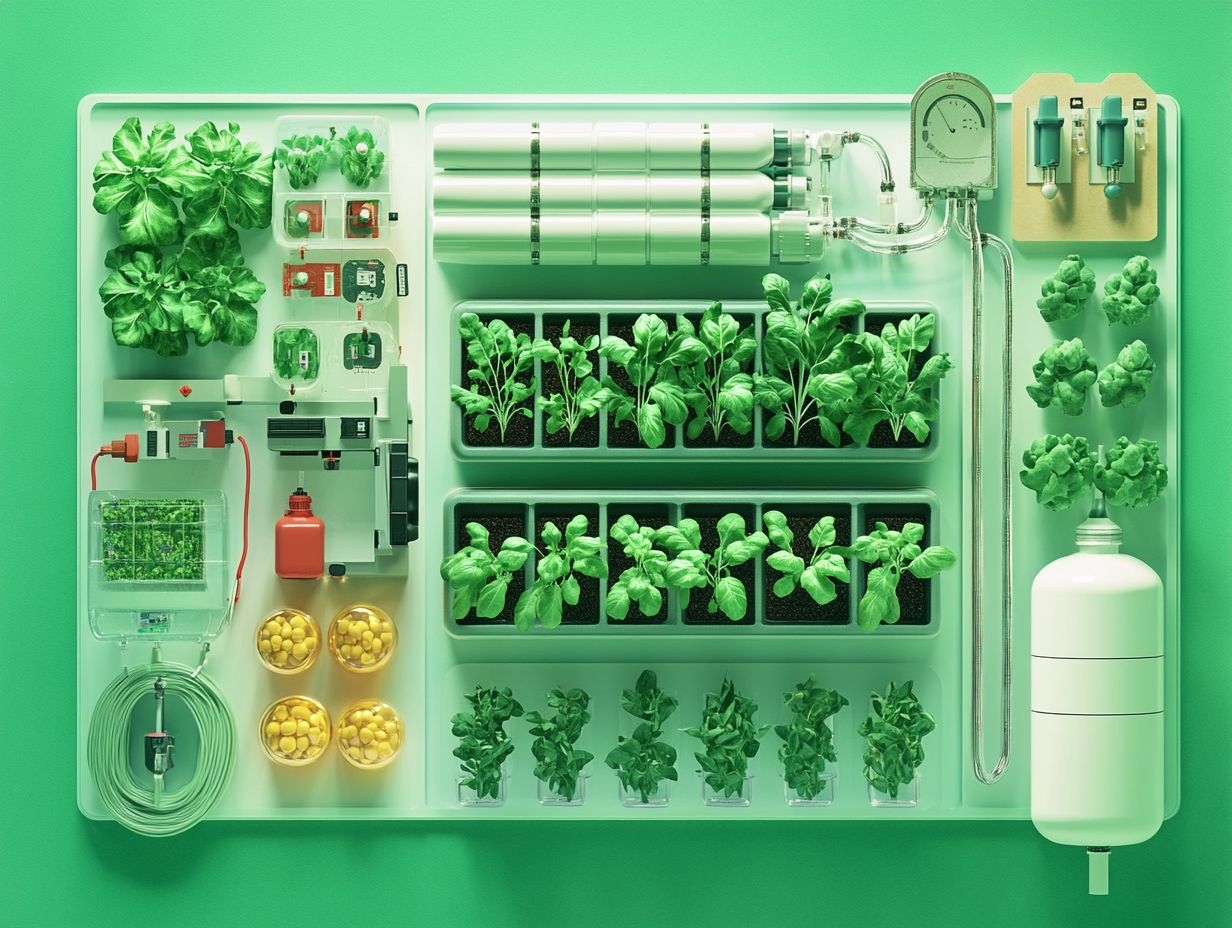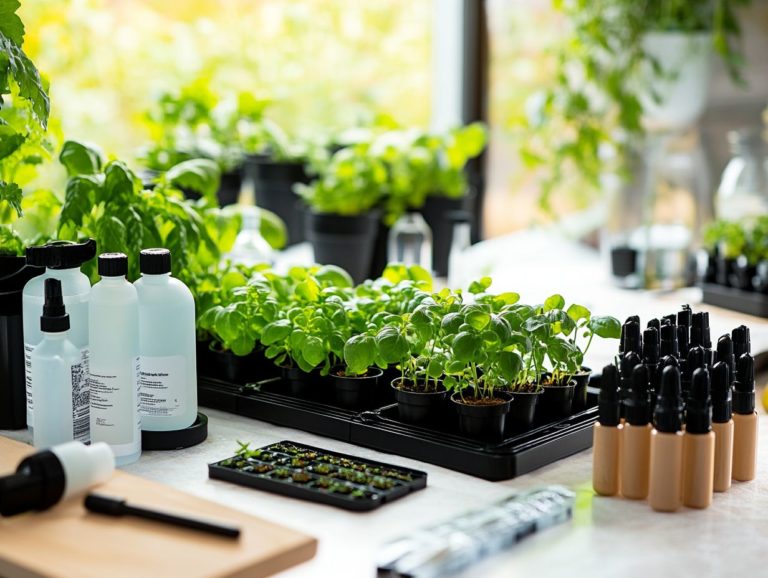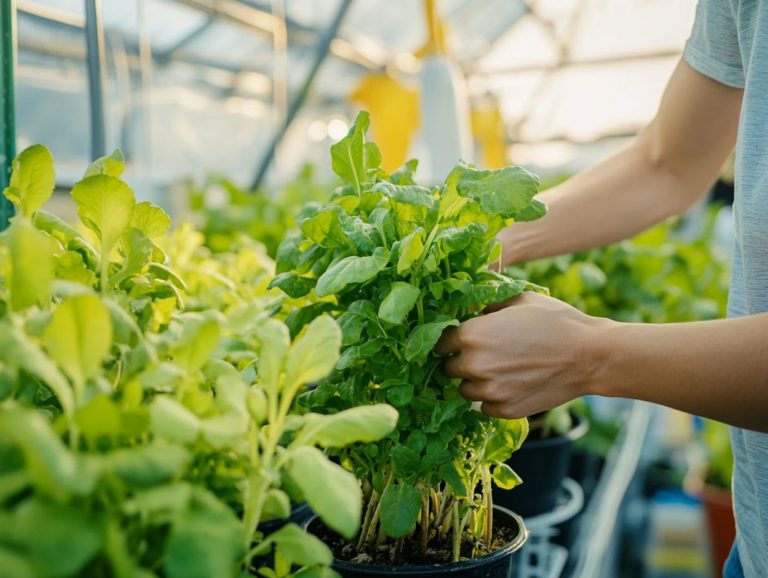Understanding Hydroponic System Components
Imagine growing plants without soil! Hydroponics makes this possible, enabling cultivation without the need for traditional soil and allowing for optimal plant nutrition.
This article delves into the essential components of a hydroponic system, covering everything from growing mediums and nutrient solutions to the technology that keeps your garden flourishing, such as grow lights and water pumps. You’ll also learn about essential nutrients for plant growth.
You’ll find guidance on selecting the right components, setting up your system, and maintaining it for optimal success. Whether you’re just starting out or ready to boost your gardening skills quickly, this comprehensive guide will put you on the path to thriving in the world of hydroponic gardening, emphasizing sustainable agriculture practices.
Contents
- Key Takeaways:
- Components of a Hydroponic System
- Choosing the Right Components
- Setting Up a Hydroponic System
- Maintaining and Troubleshooting Your System
- Frequently Asked Questions
- What are the main components of a hydroponic system?
- What is the function of the reservoir in a hydroponic system?
- What role does the pump play in a hydroponic system?
- What is the purpose of the growing container in a hydroponic system?
- What are some common growing mediums used in hydroponic systems?
- Why is understanding the components of a hydroponic system important?
Key Takeaways:

- Hydroponic systems use water, nutrients, and grow lights to grow plants without soil.
- The key components of a hydroponic system are growing mediums, nutrient solutions, grow lights, water pumps, and aeration systems, all crucial for maximizing crop yields.
- When setting up a hydroponic system, consider factors like plant type, cost, and maintenance before choosing the right components.
What is Hydroponics?
Hydroponics presents a revolutionary approach to cultivating plants without the constraints of soil, using nutrient solutions to deliver essential elements directly to the plant roots. This method ensures their nutrient needs are met and amplifies crop yields. It also promotes efficient water conservation, solving water management issues in agricultural practices. Its historical roots can be traced back to marvels like the Hanging Gardens of Babylon and ancient Mesoamerica, evolving through modern advancements, including innovative projects endorsed by NASA for space farming.
The adoption of hydroponics has grown remarkably, particularly amid rising global populations and the diminishing availability of arable land. This soil-less technique offers extraordinary benefits, such as the precise control of nutrient levels, resulting in healthier plants that often outpace their soil-grown counterparts in growth speed.
Hydroponic systems consume significantly less water, a crucial advantage in regions where water scarcity is a pressing concern. As a cornerstone of sustainable agriculture, hydroponics diminishes the reliance on harmful pesticides and fertilizers. This fosters a cleaner environment and enables urban areas to cultivate fresh produce locally.
By leveraging cutting-edge technology and ongoing research, hydroponics is poised to revolutionize our approach to food production and plant nutrition, ensuring optimal nutrient balance to address food security challenges in truly innovative ways.
Components of a Hydroponic System
A hydroponic system comprises several essential components that harmoniously collaborate to foster an ideal environment for plant growth. Key elements include the nutrient reservoir, the growing medium, and the nutrient solutions that are critical for maintaining plant health, particularly in relation to nutrient uptake and interactions.
Grasping the function of each component is paramount for achieving effective plant nutrition and growth. Factors such as water quality, electrical conductivity (which refers to how well water can carry an electric current, indicating nutrient levels), and optimal pH levels (which measure the acidity or alkalinity of the solution) play a significant role in influencing nutrient uptake and, ultimately, the success of your crop yields.
Start your hydroponic garden today and enjoy fresh produce at home!
Growing Mediums
Growing mediums play a crucial role in hydroponic systems, supporting plant roots and helping with nutrient availability. This creates optimal growth conditions for various crops, including favorites like tomatoes!
Unlike traditional soil, these mediums come in various compositions, each offering unique benefits that enhance nutrient uptake and contribute to sustainable agricultural practices.
Take rock wool, for instance. Made from volcanic rock, it provides excellent aeration and moisture retention, making it a popular choice among growers. In contrast, coconut coir has a high water-holding capacity and is biodegradable, making it an environmentally friendly option.
Perlite and vermiculite are also lightweight materials that improve drainage and aeration, effectively preventing root rot.
However, traditional soil can bring its own challenges, such as pests and diseases. Nutrient deficiencies are often less of a concern in hydroponic setups. By understanding the unique properties of these mediums and ensuring the right nutrient mix, you can customize your systems to maximize crop yields and ensure healthy plant development.
Nutrient Solutions
Nutrient solutions are vital for your hydroponic system, providing essential macronutrients and micronutrients that your plants need to thrive. Understanding nutrient balance is crucial. Deficiencies in key elements like calcium, magnesium, or iron can lead to serious problems, impacting your crop yields and the overall health of your plants!
Nutrient solutions include the three main nutrients that plants need in larger amounts: nitrogen, phosphorus, and potassium, as well as sulfur. Each plays a specific role in plant health. For example, nitrogen encourages lush foliage, while phosphorus is key for robust root development and flowering.
Micronutrients, although needed in smaller quantities, are equally important. Elements like boron and zinc help facilitate essential biochemical processes. A well-crafted nutrient blend boosts growth rates and enhances disease resistance, ensuring minimal nutrient antagonism and optimal nutrient availability!
If you neglect your nutrient balance, you might face stunted growth, yellowing leaves, or even poor fruit development, jeopardizing your hydroponic farming success. Regularly monitoring and adjusting your nutrient solutions for pH levels and nutrient status is essential for achieving optimal results. Don t wait until it s too late!
Grow Lights

Grow lights are absolutely essential in hydroponics. They provide the crucial light spectrum needed for photosynthesis, the process through which plants use light to make food! This boosts chlorophyll production in your hydroponic plants, facilitating maximum growth.
By simulating natural sunlight, these lights ensure consistent and efficient growth no matter what s happening outside! This makes them essential for both indoor and vertical farming.
There are different types of grow lights available, including LED, fluorescent, and high-pressure sodium (HPS) lights. Each has unique characteristics that can significantly influence plant development.
For instance, while LEDs are energy-efficient and allow you to customize the light spectrum, HPS lights provide a more intense light output, though at a higher energy cost. The specific spectrum emitted by these lights directly affects how effectively your plants absorb light, which impacts chlorophyll synthesis and overall growth rates, influencing nutrient uptake.
Finding the right balance of intensity and spectrum is crucial, as it directly correlates with crop yields. This optimization is key for enhancing growth phases, whether you re nurturing hydroponic plants during their vegetative or flowering stages. It s vital for both produce enthusiasts and commercial growers alike!
Water Pumps
Water pumps are vital for hydroponic systems. They help circulate nutrient solutions, ensuring plants absorb the nutrients effectively. By maintaining a consistent water flow, these pumps are crucial to irrigation systems that promote sustainable agricultural practices and enhance crop yields.
These devices come in various types, including submersible, inline, and air pumps. Each type is designed for specific applications within your hydroponic setup. Submersible pumps are quiet and work well underwater, making them perfect for deep water culture systems. Inline pumps provide versatility and can handle larger volumes of liquid, which is ideal for nutrient delivery across expansive setups. Air pumps, on the other hand, introduce essential oxygen into the nutrient solution, promoting robust root health and enhancing nutrient uptake. For more information on maintaining these systems, check out our guide on understanding hydroponic system maintenance.
By understanding specifications such as flow rate and pressure, you can confidently select the ideal pump. This choice will elevate the efficacy and productivity of your hydroponic systems while ensuring optimal nutrient delivery.
Aeration Systems
Aeration systems are crucial in hydroponics, delivering the oxygen your nutrient solution needs to thrive. This infusion of oxygen enhances nutrient uptake and promotes overall plant health, preventing issues related to nutrient deficiencies.
Efficient aeration significantly boosts microbial activity in the root zone. This fosters beneficial relationships between your plants and microorganisms that aid in nutrient absorption and overall plant growth. You can choose from various methods, such as air stones, diffusers, and bubble wands. Each method offers distinct advantages that contribute to sustainable agricultural practices.
Integrating effective aeration techniques can reduce your overall fertilizer usage, lessening your environmental footprint while improving yield quality in your hydroponic crops. As hydroponic farming gains traction, applying proper aeration techniques is vital for cultivating healthy, resilient crops sustainably.
Choosing the Right Components
Selecting the right components for your hydroponic system is essential for achieving optimal plant growth. It’s crucial for ensuring proper nutrient balance and maximizing crop yields. Factors such as water quality, nutrient solutions, and growing mediums significantly impact the overall success of your setup.
Understanding how these components interact allows you to customize your system to meet your plants’ specific needs. For a deeper insight, check out understanding hydroponic system cycles. This ensures they receive the ideal nutrient uptake for robust growth.
Factors to Consider
When selecting components for your hydroponic system, consider key factors like water quality, nutrient availability, and the specific growing conditions required for your plants. Each element is vital for achieving the perfect nutrient balance, directly affecting the success of your cultivation process.
Water quality is especially critical; it should be free from contaminants and have the right pH level for optimal nutrient absorption. Your choice of nutrients is equally important, as they provide essential minerals for robust growth. Also, consider environmental factors like light intensity and temperature, which can significantly influence plant health.
By optimizing these various aspects, you can establish a thriving hydroponic system that nurtures strong, healthy plants and maximizes yield.
Setting Up a Hydroponic System

Establishing a hydroponic system requires a series of meticulous steps designed to create the ideal conditions for plant growth. You’ll need to choose the right nutrient solutions and components tailored to your system.
This thoughtful approach is essential for maximizing crop yields and fostering a sustainable growing environment, especially in vertical farming scenarios.
Step-by-Step Guide
A step-by-step guide to establishing a hydroponic system begins with determining the most suitable growing method. Next, select the right nutrient solutions and ensure that your irrigation systems function seamlessly.
Each step is essential in crafting an optimal environment for plant growth and nutrient absorption. As you embark on this journey, it is vital to educate yourself about various hydroponic methods such as nutrient film technique (NFT), deep water culture (DWC), and aeroponics.
Each method comes with its own set of unique advantages and challenges that you will need to consider. Grasping the significance of nutrient solutions cannot be overlooked.
Delve into the ideal mix of macro and micronutrients specifically tailored for your chosen plants. This knowledge is key to ensuring their optimal health and growth rates.
Setting up an efficient irrigation system is essential to keep your garden thriving! Whether using timed drip emitters or flood-and-drain techniques, maintaining consistent moisture levels and effective nutrient distribution is critical.
This foundation will ultimately lead you to a thriving hydroponic garden.
Maintaining and Troubleshooting Your System
Maintaining and troubleshooting your hydroponic system is vital for ensuring plant health and maximizing crop yields. Issues such as nutrient deficiencies or water quality can significantly impact your results, so staying vigilant is key.
Regular monitoring and attentive care are essential for sustaining the optimal growing conditions your hydroponic plants need to thrive.
Tips for Proper Maintenance
Properly maintaining your hydroponic systems requires a keen eye on water quality and nutrient status. Regular monitoring can prevent issues that might hinder plant growth and overall system efficiency.
By implementing routine checks and adjustments, you can ensure your hydroponic plants thrive and optimize their nutrient uptake. To achieve this, it’s crucial to test pH levels and electrical conductivity (EC) frequently.
These metrics directly influence nutrient availability. Keeping the pH between 5.5 and 6.5 allows your plants to absorb nutrients effectively.
Monitor nutrient concentration to adjust the solution according to the specific needs of your plants, especially during critical growth stages.
Regularly replacing the nutrient solution and ensuring proper aeration in the water will further enhance nutrient distribution. This reduces the risk of deficiencies or toxicities that could impede plant development.
By taking these steps, you’re setting yourself up for a flourishing hydroponic garden.
Common Issues and How to Fix Them
Common issues in hydroponic systems often revolve around nutrient deficiencies, such as calcium, iron, or magnesium shortages. These deficiencies can negatively affect plant health and growth.
It is essential to understand how to identify these problems and implement effective solutions to create a thriving hydroponic environment. Recognizing the signs of nutrient deficiencies is vital for any grower.
For instance, yellowing leaves might signal a nitrogen deficiency, while poor fruit development could suggest a lack of potassium. Monitoring the nutrient solution’s pH and electrical conductivity is key to ensuring optimal absorption of these essential elements.
To tackle nutrient issues, adjust the nutrient ratios in your solution and make use of high-quality supplements. Regularly inspecting your plants and maintaining detailed records can significantly aid in early detection.
This ensures that your plants receive the precise nutrition they need to truly flourish.
Frequently Asked Questions

What are the main components of a hydroponic system?
The main components of a hydroponic system include a reservoir, a pump, a growing container, a growing medium, and a nutrient solution.
What is the function of the reservoir in a hydroponic system?
The reservoir holds the nutrient solution and provides a constant supply of water and nutrients to the plants.
What role does the pump play in a hydroponic system?
The pump circulates the nutrient solution from the reservoir to the plants, ensuring they receive a continuous supply of nutrients.
What is the purpose of the growing container in a hydroponic system?
The growing container supports the plants and holds the growing medium. This setup allows the roots to absorb essential nutrients from the nutrient solution.
What are some common growing mediums used in hydroponic systems?
Some popular growing mediums are rockwool, perlite, coconut coir, and clay pebbles. Each medium has unique benefits and is suitable for various types of plants.
Why is understanding the components of a hydroponic system important?
Knowing the components of a hydroponic system is vital for successful setup and maintenance. This knowledge helps you troubleshoot effectively and ensures your plants get the nutrients they need to thrive.






